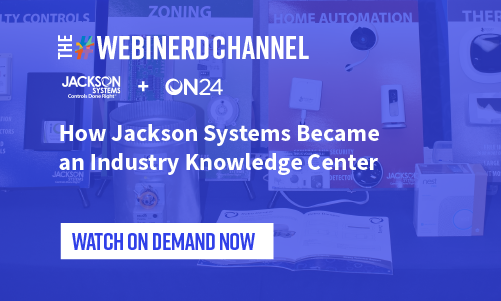9 Ways Manufacturing Can Engage With Online Audiences

When it comes to releasing, educating and selling a product or service, manufacturers have a lot to manage. VARs need to understand the ins and outs of a new product. Partners and customers need to be educated. Product experts need to be available to answer questions. And, of course, collateral and product portfolios need to be updated and distributed to nearly every conceivable person who sells, discusses or touches a product.
In the past, this meant manufacturers had to update, print and distribute physical product portfolios — veritable textbooks that would become obsolete nearly as soon as they were printed. Fortunately, today’s manufacturers and marketers have a new channel they can take advantage of: digital. With comprehensive digital experiences, any industry professional can create and publish the latest information they have to offer.
How? Below, we outline nine different ways. Let’s explore:
How digital experiences fit into a manufacturer’s online presence.
Manufacturing companies typically have several different audiences to connect, communicate and market to. Each audience has its own place in the manufacturing cog with unique objectives, needs and content preferences. These particularities need to be accounted for in digital marketing and online engagement the same way they would in more traditional face-to-face engagement channels.
Digital experiences — any interaction a visitor takes on an owned digital channel — can help streamline these communication efforts. They do so by providing the persona (e.g., VAR, distributor, partner or customer) with the information they need when they need it — and do so across different digital channels. When it comes to an online presence, manufacturers can use digital experiences to educate, inform, engage, test and offer a two-way channel between the manufacturer and its constituents. Think of a digital experience as an always-on, always accessible, up-to-date point person that provides a consistent and compelling experience for the person on the other end.
Demand Generation/Partners
When it comes to marketing (or otherwise promoting) manufacturing, you need to start with generating demand. Often, that means enabling partners and end-users with the latest information on your products. But education and enablement can be difficult, especially as partner and VAR supply bases and competition has taken off. To stand out, manufacturers must communicate their advantages on every channel possible.
Manufacturers have several options for engagement here. With a manufacturer-provided resource, end-users can evaluate a product, ask product experts questions and can be empowered to — in turn — generate quality leads, drive sales. Digital channels and experiences can simplify this process by allowing a manufacturer’s audience to digest material easily without coordinating an in-person meeting.
-
- Resource Content Hubs – Content Hubs are like a personalized library for each business partner. They contain the latest product information so partners and end-users can easily and quickly go to one place to find all the information they need — a company’s one-stop-shop for product information, if you will.
Within content hubs, manufacturers can categorize products, methods and other pertinent information that sets them apart from competitors. For example, a single content hub can organize a breadth of material from product deep-dives with engineers and spec sheets to thought leadership events and seminars on relevant content from respected experts in the field.
Content hubs are important for any business, but doubly so for manufacturing. With an integrated analytics solution, marketers and salespeople can capture audience and account data to qualify leads better, track their progress through the buying journey and quickly identify the most engaging content for partners.
-
- Partner Resource Pages – Target pages are landing pages designed to connect with a particular audience. For example, a branded page can act as a resource for a specific partner or another page could be set up to discuss a particular use case. Often, these pages share additional information that isn’t the right fit for a content hub or a public-facing webpage. As new products are released, or industry regulations change, manufacturers can use these digital experience sub-pages to share communications and announcements and directly engage with audiences on a more personable level.
Let’s say you want to set up a product portfolio for a particular partner. Using your partner’s logo, you can set up a target page that’s specifically for them and filled with resources — from product guides and features to deep-dive webinars — that they will actually use. With the right integrations in place, you can also put your partners in direct contact with a salesperson (or even an engineer) should they have any questions.
-
- Deep Dive Webinars – Webinars are a virtual events solution for manufacturing, a great tool for manufacturers to create an interactive learning experience for their partners and end-users. Webinars can include demonstrations of new products or updates and can be used to record thought leadership presentations. For manufacturing, webinars are an excellent opportunity to go beyond a basic product portfolio and give partners a deep dive into each item itself.
For example, say a manufacturer introduces a new product. That manufacturer can then produce a live deep-dive webinar that features engineers who’ve worked on the product. Audiences can ask questions and those engineers can either respond in real-time or send a response to the query over email. But that’s not the end of webinar possibilities. The manufacturer can also create thought leadership webinars for partners and VARs to help position the product within the market, a webinar series detailing how a product works in different scenarios and offer best practices and more. Once these webinars are over, manufacturers can place them in content hubs and targeted pages for on-demand viewing.
Distributors
Distributors are the people who get the products to the customers. They need to understand the details of the products they’re selling and explain how customers will find it desirable, so resellers and sellers can move stock. As such, they’ll need specific guidance and training from a manufacturer on how to best transport, position and sell a product.
Manufacturers can accelerate the education and training phase through digital experiences designed to address a distributor’s needs. Here’s how:
-
- Distribution FAQ Pages – To increase online engagement with distributors, manufacturers can create training sessions that keep distributors informed and knowledgeable about the details of the products they’re selling. These training sessions work best when the content is personalized and branded for the different distributors and located on easy-to-find product-specific target pages that offer engagement opportunities while showcasing the latest brand and product content. Target pages allow distributors to quickly find what they’re looking for without forcing them to sift through cluttered content hub home pages filled with information that isn’t relevant in that moment.
- Training Sessions and Certification – With numerous interactive elements in webinars, manufacturers can provide many of the same elements in face-to-face training sessions: video instruction, take-home content, social media connections, networking, Q&As and comprehension checks. Some manufacturers, like Jackson Systems and Valeo, use webinars to train contractors, retain customers and award certifications seamlessly.
Digital experiences like webinars are the perfect virtual events solution for manufacturing, a great opportunity for manufacturers to integrate market education into communications. An educational program can gauge distributors’ understanding of products and readiness to go-to-market through surveys, quizzes, polls and testing and industry certifications. Manufacturers can distribute certificates — provided a visitor meets the right criteria — directly through an event, offering additional incentives for attending and consuming a manufacturer’s content.
-
- Resource Portal – Of course, all distributor-centric content — from educational resources about the products and manufacturer to technical deep dives — can be placed on a content hub for easy access. Content hubs are great resources for distributors because they can find product information — again, like guides, instructions and deep dives — at virtually anytime, anywhere.
Customers
A manufacturer’s end-user is the customer. But, with a modern global market and access to almost anything online, customers have many options that meet their needs when choosing a product or service. This wealth of opportunities and competition is why manufacturers need to continually re-establish brand reputation while also differentiating themselves from competitors. The goal is to remain top-of-mind for customers while simultaneously meeting customer demands and expectations.
Digital content experiences are an excellent resource for driving this engagement at scale. Digital experiences enable manufacturers — and their distributors — to expand reach, drive brand recognition and break through the digital noise. To make the customer experience a stellar one, manufacturers can drive digital engagement through comprehensive product information. Here’s an example:
-
- Start with an education hub – Like with communication with partners and distributors, manufacturers can offer continuing professional education services via content hubs. Acting as self-serve learning portals that provide a library of on-demand product and brand content, these hubs can showcase an organization’s product portfolio and help nurture customers.
- Create a product page – Product pages are dedicated landing pages detailing a specific product. Within these pages, manufacturers could publish resources, learning modules and opportunities to engage as they ask questions, should they need to. Manufacturing marketers can also post information like product and brand announcements for better awareness.
- Convert and connect via webinars – Finally, there are the webinars that fuel the content on targeted landing pages and content hubs. Webinars are versatile, scalable and applicable to virtually any scenario a manufacturing marketer can think of. Marketing managers can make product demos, technical deep dives and Q&A sessions with engineers and technical teams easily available to prospects and customers.
Manufacturers will need to make the most out of each digital experience. Often, this means including engagement tools like calls-to-action, virtual business cards, social media links, Q&As and chatbots for direct communication and customer service across every digital channel. For more about how you can take your digital experiences to the next level, check out our manufacturing hub here.

